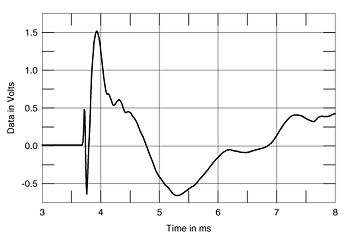| Columns Retired Columns & Blogs |
Genesis Technologies 500 loudspeaker Measurements part 3
Below 1kHz, the on-axis notch actually increases in frequency well to the speaker's sides, but is joined by another notch an octave lower. Again, this off-axis behavior will tend to make the speaker sound laid-back, or even colored in very reverberant rooms. In the vertical plane (fig.8) the 800Hz notch is ubiquitous, other than at angles lower than 10 degrees below the tweeter axis. But other than that and the tweeter's limited top-octave dispersion, the balance doesn't change very much with listener height. Only when the listener is standing does a classic crossover notch develop, revealed by the cursor in this graph to lie at 3.3kHz.

Fig.8 Genesis 500, vertical response family at 50", from back to front: responses 10 degrees-5 degrees above HF axis, reference response, responses 5 degrees-15 degrees below HF axis.
The Genesis's impulse response (fig.9) appears conventional, though some mid-frequency ringing can be seen after the main impulse. (The small blip just after the 7.5ms mark in this graph is the first room reflection.) The step response (fig.10) indicates that the tweeter and midrange units are both connected with the same positive acoustic polarity, but that the former leads the latter by an inconsequential 100µs or so. Again, the ringing can be seen; its period is around 1.25ms, corresponding exactly to the 800Hz frequency of the on-axis notch.

Fig.9 Genesis 500, impulse response on tweeter axis at 50" (5ms time window, 30kHz bandwidth).

Fig.10 Genesis 500, step response on tweeter axis at 50" (5ms time window, 30kHz bandwidth).
- Log in or register to post comments




































